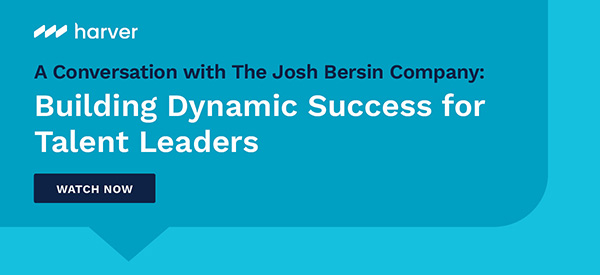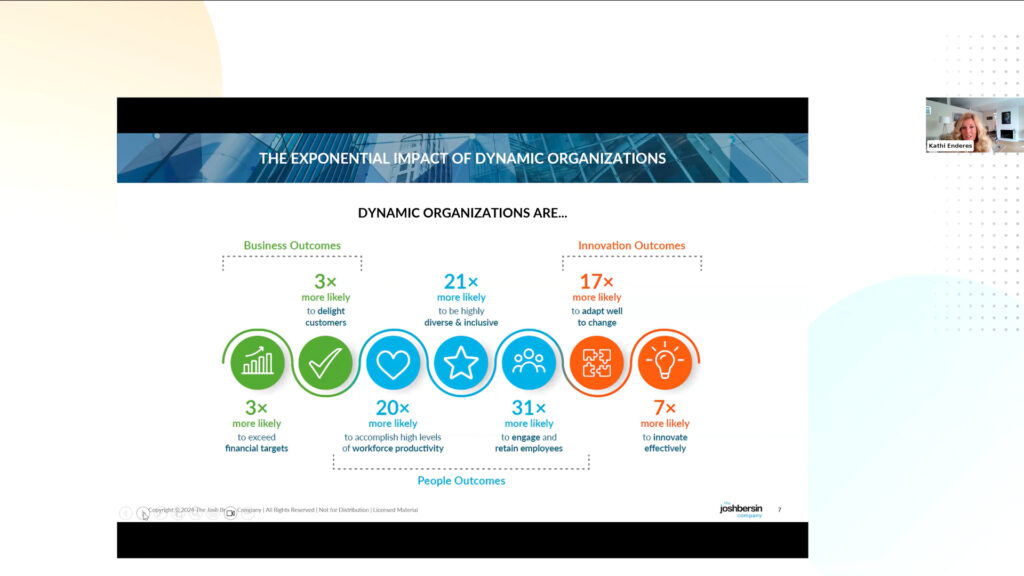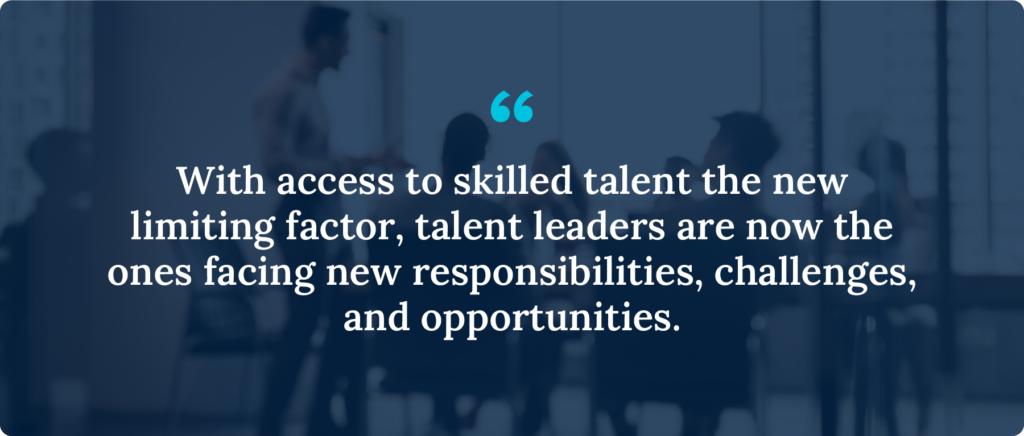Missed our recent Building Dynamic Success for Talent Leaders webinar? Catch up on what every talent leader needs to know, with these five key takeaways on why and how HR is uniquely responsible for driving dynamic organizational success.
During this chat with The Josh Bersin Company, researchers Kathi Enderes and Stella Ioannidou joined our host Ali Good, Harver’s VP of Product Marketing. Read on as Ali recaps her 5 key takeaways from the webinar, which is now available to watch on-demand.

What's in?
What is a dynamic organization?
Before we get into takeaways, here’s a quick primer on what a dynamic organization is.
According to The Josh Bersin Company, dynamic organizations are capable of:
- Being architected for change.
- Proactively anticipating changes in the business environment.
- Continuously transforming at speed and scale to drive outcomes.
- Strategically aligning people and skills to improve both productivity and competitiveness.
Takeaway #1: Dynamism is essential for growth and productivity
First, how does enabling a dynamic organization help you as a talent leader? How does it help your teams and your organization as a whole?
According to research from The Josh Bersin Company, dynamic organizations can achieve exponential impact. These positive outcomes that fuel business growth and workforce productivity extend throughout the broader organization.
Here are just a few examples you’ll learn during our webinar when it comes to: What kind of impact can dynamic organizations drive?
- People outcomes, like 31x more likely to engage and retain employees
- Business outcomes, like 3x more likely to exceed financial targets
- Innovation outcomes, like 17x more likely to adapt well to change

Takeaway #2: Today’s “Intelligence Era” spotlights CHROs
Starting in the 1970s, legacy companies like IBM and AT&T led the Information Age. Talent models focused on a war for skills and developing leadership pipelines. IT technology and skills drove business success, offering new power and opportunities for Chief Information Officers.
In today’s Intelligence Era, modern heavyweights like Google and Microsoft are leading the way. But the global talent shortage is at a 17-year-high. CHROs are simultaneously hot stuff and in the hot seat. With access to skilled talent the new limiting factor, talent leaders are now the ones facing new responsibilities, challenges, and opportunities.

Takeaway #3: Uncertainty demands a dynamic talent model
Becoming a dynamic organization is essential to achieving both growth and productivity. Recruiting isn’t enough. Mobilizing your internal workforce, redesigning jobs, and developing talent are now requirements.
We’re not in the Industrial Age, when workers were abundant and interchangeable. Workers and skills are scarce. Rigid talent models centered on the job itself must give way to people-centric talent models. Why? Because talent are now the limiting factor for innovation and the ability to adapt as external and internal environments evolve.
Takeaway #4: The shift to recruiters as “talent advisors”
In the past, Talent Acquisition teams were seen as transactional paperwork pushers. Their main role was to buy talent and to buy it fast. Recruitment process speed still matters, of course. Like for a BPO customer that slashed time to interview from a week to just 35 minutes by transforming their process.
But dynamic organizations thrive because they do more than simply rely on external hiring. Their talent teams focus on reskilling or upskilling talent sustainably. Their recruiters focus on advising hiring managers about critical skills and competencies needed for success. Siloed TA, TM, and L&D teams are giving way to more enmeshed, collaborative teams that together enable dynamic innovation across the organization.

Takeaway #5: The 4 Rs of systemic HR
Traditional HR operates more as individual teams with little cross-collaboration between talent acquisition, talent management, learning & development, and wider HR teams like pay & rewards. To enable true dynamism across the organization, HR needs to operate systemically as a whole.
To help you prioritize, Kathi Enderes from The Josh Bersin Company shares what moves the needle most. By operating as a cohesive unit, HR can then better forecast what’s to come and respond to unforeseen changes. For example, see the slide below. Strategic priority and performance metrics help inform skills-based mobility, upskilling for productivity, and reskilling for growth.

Don’t worry, you don’t have to do it alone. AI and other HR tech advancements help accelerate progress towards building a dynamic organization.
Make sure to catch the full webinar – you don’t want to miss the 4 Rs of systemic HR:
- Recruiting
- Retaining
- Reskilling
- Redesigning
Watch now: Dynamic organizations webinar
In today’s Intelligence Era, you and other talent leaders can’t afford to stay static. Driving people and business outcomes is now a CHRO’s opportunity and responsibility. To make that happen, you need to lay the groundwork for organizational agility.
Watch our free Building Dynamic Success for Talent Leaders webinar to take your next step.


